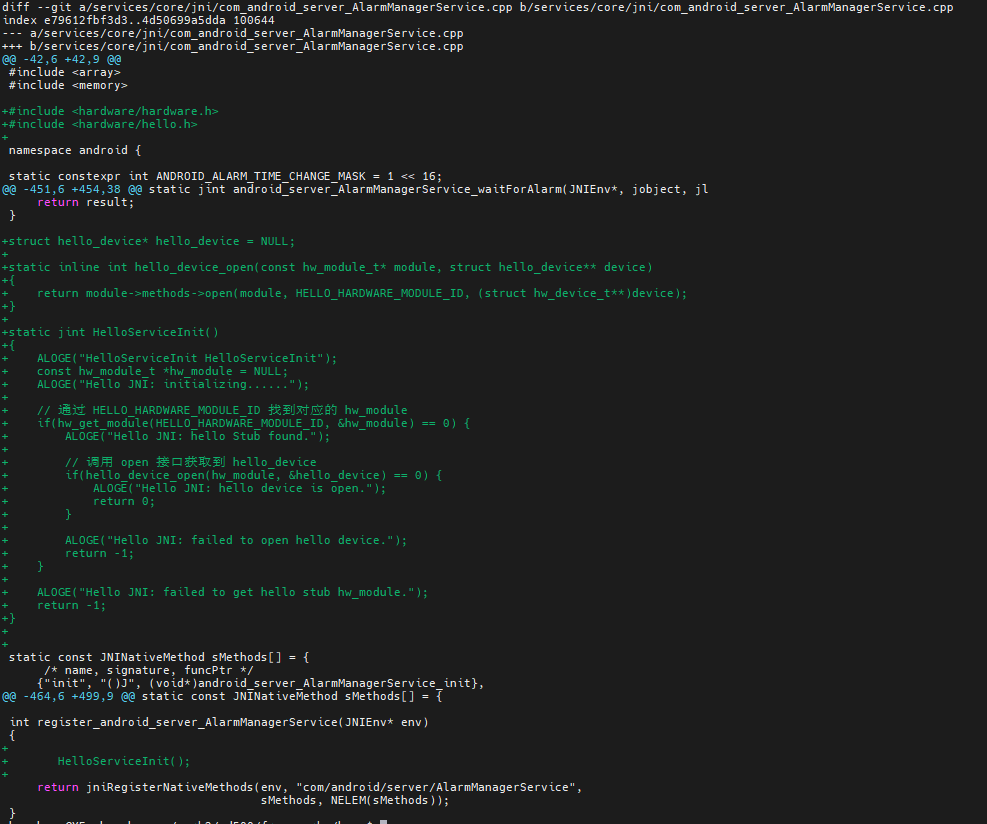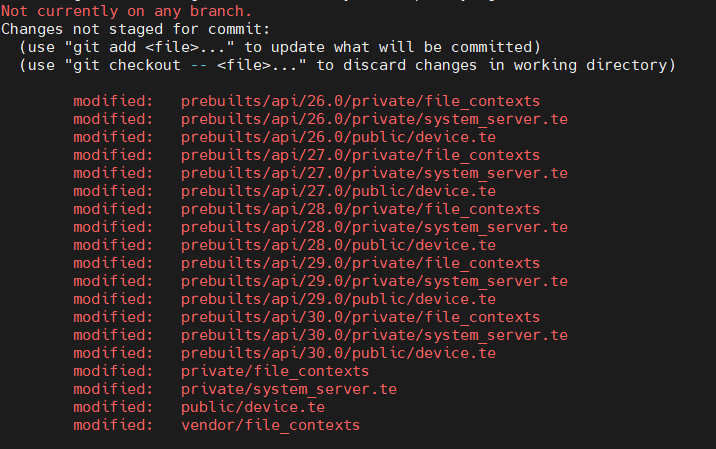文章目录
- 1. 数据结构
- 1) hw_module_t
- 2) hw_module_methods_t
- 3) hw_device_t
- 2. 程序编写
- 3. 编译程序
- 4. 验证程序
- 5. 添加权限
- 1) 设备节点添加权限
- 2) 添加 shell linux 权限
作者: baron
对 linux 驱动程序进行封装,其主要设计意图是向下屏蔽设备以及其驱动的实现细节,向上为系统服务以及 Framework 提供提供统一的设备访问接口。就是 linux 驱动只提供硬件读写接口, 业务逻辑通过 hall 封装成 so 库. 这样就不用遵循 kernel 的 gpl 开源协议, 从而保护厂商的利益. 不过也因为这个原因安卓被 linux 踢出了内核主线程.
1. 数据结构
1) hw_module_t
用来表示硬件的抽象
- 每一个模块都必须自定义一个硬件抽象层模块结构体,而且他的第一个成员变量的类型必须为 hw_module_t.
- 硬件抽象层每一个模块都必须声明为HAL_MODULE_INFO_SYM
- 结构体 hw_module_t的成员变量 tag的值必须设置为HARDWARE_MODULE_TAG
- dso 用来保存加载硬件抽象层模块后得到的句柄值.
// libhardware/include/hardware/hardware.h typedef struct hw_module_t { uint32_t tag; // 值必须声明为 HARDWARE_MODULE_TAG uint16_t module_api_version; // 模块 API 版本 #define version_major module_api_version uint16_t hal_api_version; // HAL API 版本 #define version_minor hal_api_version const char *id; // 模块的唯一标识符, 通过该标识符查找该 module const char *name; // 模块的名称 const char *author; // 模块的作者 struct hw_module_methods_t* methods; // 模块的方法集合 void* dso; // 模块的共享对象(动态共享库) #ifdef __LP64__ uint64_t reserved[32-7]; // 保留字段,64 位系统上使用 64 位整数数组 #else uint32_t reserved[32-7]; // 保留字段,32 位系统上使用 32 位整数数组 #endif } hw_module_t;2) hw_module_methods_t
封装 open 函数, 通过 open 函数获取 hw_device_t
// libhardware/include/hardware/hardware.h typedef struct hw_module_methods_t { int (*open)(const struct hw_module_t* module, const char* id, struct hw_device_t** device); } hw_module_methods_t;3) hw_device_t
open 函数返回的结构, 硬件设备结构的第一个结构.
- tag的值必须设置为HARDWARE_DEVICE_TAG
- close 回调接口用来关闭设备
// libhardware/include/hardware/hardware.h typedef struct hw_device_t { uint32_t tag; // 赋值为 HARDWARE_DEVICE_TAG uint32_t version; // 版本号 struct hw_module_t* module; // 属于哪个 hw_module_t #ifdef __LP64__ uint64_t reserved[12]; #else uint32_t reserved[12]; #endif int (*close)(struct hw_device_t* device); // close 方法 } hw_device_t;有了这几个接口就可以用来封装我们驱动接口了.
2. 程序编写
创建头文件: hardware/libhardware/include/hardware/hello.h内容如下.
// include/hardware/hello.h #ifndef ANDROID_INCLUDE_HARDWARE_HELLO_H #define ANDROID_INCLUDE_HARDWARE_HELLO_H #include
#include #include #include #include #include #define HELLO_HARDWARE_MODULE_ID "hello" // 创建一个 hello_module_t 类用来描述硬件的抽象 // 它的第一个结构必须是 hw_module_t // 它必须被实例化为 HAL_MODULE_INFO_SYM typedef struct hello_module { struct hw_module_t common; }hello_module_t; // 硬件设备结构 hello_device // 它的第一个结构必须为 hw_device_t, 因为这样就可以通过 hw_device_t 拿到 hello_device typedef struct hello_device { struct hw_device_t common; int fd; int (*write_string)(struct hello_device* dev, const char *str); int (*read_string)(struct hello_device* dev, char* str); }hello_device_t; #endif /* ANDROID_INCLUDE_HARDWARE_HELLO_H */ 创建 hardware/libhardware/modules/hello/hello.c文件
// hardware/libhardware/modules/hello/hello.c` #define LOG_TAG "Legacy HelloHAL" #include
#include #include #include #include #include #include #include #include #include #include #include #include #define DEVICE_NAME "/dev/hello" #define MODULE_NAME "Default Hello HAL" #define MODULE_AUTHOR "The Android Open Source Project" // 接口声明 static int hello_device_open(const struct hw_module_t* module, const char* name, struct hw_device_t** device); static int hello_device_close(struct hw_device_t* device); static int hello_write_string(struct hello_device* dev, const char * str); static int hello_read_string(struct hello_device* dev, char* str); // 创建 hw_module_methods_t 用来提供 open 方法 static struct hw_module_methods_t hello_module_methods = { .open = hello_device_open, }; // 实例化 hello_module_t 硬件抽象模块为 HAL_MODULE_INFO_SYM // ******** 必须实例化为 HAL_MODULE_INFO_SYM 这个名字不能变 hello_module_t HAL_MODULE_INFO_SYM = { .common = { .tag = HARDWARE_MODULE_TAG, // 必须设置为这个 tag .module_api_version = 1, .hal_api_version = 1, .id = HELLO_HARDWARE_MODULE_ID, // 通过这个查找对应的 moduel .name = MODULE_NAME, .author = MODULE_AUTHOR, .methods = &hello_module_methods, // 设置 open 方法 }, }; // open 方法的具体实现 static int hello_device_open(const struct hw_module_t* module, const char* name, struct hw_device_t** device) { // 创建一个 hello_device_t 结构 hello_device_t *dev = malloc(sizeof(hello_device_t)); memset(dev, 0, sizeof(hello_device_t)); ALOGE("Hello: hello_device_open name = %s",name); dev->common.tag = HARDWARE_DEVICE_TAG; // 必须设置为 HARDWARE_DEVICE_TAG dev->common.version = 0; dev->common.module = (hw_module_t*)module; // 设置 module dev->common.close = hello_device_close; // 设置关闭设备接口 dev->write_string = hello_write_string; // 设置 write 方法 dev->read_string = hello_read_string; // 设置 read 方法 // 打开设备 if((dev->fd = open(DEVICE_NAME, O_RDWR)) == -1) { ALOGE("Hello: open /dev/hello fail-- %s.", strerror(errno));free(dev); return -EFAULT; } // 返回 hw_device_t 结构 *device = &(dev->common); ALOGE("Hello: open /dev/hello successfully."); return 0; } // 关闭设备释放资源 static int hello_device_close(struct hw_device_t* device) { // 通过 device 可以拿到 hello_device struct hello_device* hello_device = (struct hello_device*)device; if(hello_device) { close(hello_device->fd); free(hello_device); } return 0; } // 写方法实现 static int hello_write_string(struct hello_device* dev,const char * str) { ALOGE("Hello:write string: %s", str); write(dev->fd, str, sizeof(str)); return 0; } // 读方法实现 static int hello_read_string(struct hello_device* dev, char* str) { ALOGE("Hello:read hello_read_string"); read(dev->fd,str, sizeof(str)); return 0; } 3. 编译程序
创建 hardware/libhardware/modules/hello/Android.bp添加内容如下.
cc_library_shared { name: "hello.default", relative_install_path: "hw", proprietary: true, srcs: ["hello.c"], cflags: ["-Wall", "-Werror"], header_libs: ["libhardware_headers"], shared_libs: [ "liblog", "libcutils", "libutils", ], }在 build/make/target/product/full_base.mk中添加如下内容, 将我们的添加的 hall 库编译进系统.对应的位置为 /vendor/lib/hw/hello.default.so.
diff --git a/target/product/full_base.mk b/target/product/full_base.mk index ffd3cde11a..9f7270bd2f 100644 -- a/target/product/full_base.mk ++ b/target/product/full_base.mk @@ -32,7 +32,8 @@ PRODUCT_PACKAGES += \ # audio.a2dp.default is a system module. Generic system image includes # audio.a2dp.default to support A2DP if board has the capability. PRODUCT_PACKAGES += \ - audio.a2dp.default + audio.a2dp.default \ + hello.default
运行 ./build.sh -UKAup编译代码. 编译完成之后可以在 out 目录下发现 hello.default
$ find out/ -name "hello\.default" out/soong/.intermediates/hardware/libhardware/modules/hello/hello.default
4. 验证程序
添加验证代码 frameworks/base/services/core/jni/com_android_server_AlarmManagerService.cpp修改如下

对应代码
#include
#include struct hello_device* hello_device = NULL; static inline int hello_device_open(const hw_module_t* module, struct hello_device** device) { return module->methods->open(module, HELLO_HARDWARE_MODULE_ID, (struct hw_device_t**)device); } static jint HelloServiceInit() { ALOGE("HelloServiceInit HelloServiceInit"); const hw_module_t *hw_module = NULL; ALOGE("Hello JNI: initializing......"); // 通过 HELLO_HARDWARE_MODULE_ID 找到对应的 hw_module if(hw_get_module(HELLO_HARDWARE_MODULE_ID, &hw_module) == 0) { ALOGE("Hello JNI: hello Stub found."); // 调用 open 接口获取到 hello_device if(hello_device_open(hw_module, &hello_device) == 0) { ALOGE("Hello JNI: hello device is open."); return 0; } ALOGE("Hello JNI: failed to open hello device."); return -1; } ALOGE("Hello JNI: failed to get hello stub hw_module."); return -1; } 修改 system/sepolicy/vendor/file_contexts添加库的位置让系统能够找到, 该正则表达式指定了库的位置为 /vendor/lib64/hw/hello.default.so
diff --git a/vendor/file_contexts b/vendor/file_contexts index 1b2bc2357..92c166b6c 100644 -- a/vendor/file_contexts ++ b/vendor/file_contexts @@ -86,6 +86,7 @@ /(vendor|system/vendor)/lib(64)?/hw/android\.hardware\.graphics\.mapper@4\.0-impl\.so u:object_r:same_process_hal_file:s0 /(vendor|system/vendor)/lib(64)?/hw/android\.hardware\.renderscript@1\.0-impl\.so u:object_r:same_process_hal_file:s0 /(vendor|system/vendor)/lib(64)?/hw/gralloc\.default\.so u:object_r:same_process_hal_file:s0 +/(vendor|system/vendor)/lib(64)?/hw/hello\.default\.so u:object_r:same_process_hal_file:s0
刷机开机打印 log 如下
01-18 07:32:55.775 419 419 E AlarmManagerService: HelloServiceInit HelloServiceInit 01-18 07:32:55.776 419 419 E AlarmManagerService: Hello JNI: initializing...... 01-18 07:32:55.778 419 419 E AlarmManagerService: Hello JNI: hello Stub found. 01-18 07:32:55.778 419 419 E Legacy HelloHAL: Hello: hello_device_open name = hello 01-18 07:32:55.778 419 419 E Legacy HelloHAL: Hello: open /dev/hello fail-- Permission denied. 01-18 07:32:55.778 419 419 E AlarmManagerService: Hello JNI: failed to open hello device.
提示没没有权限
5. 添加权限
1) 设备节点添加权限
给我们的设备节点添加权限修改路径 system/core/rootdir/如下
diff --git a/rootdir/ueventd.rc b/rootdir/ueventd.rc index 1550894ce..428cc1ec2 100644 -- a/rootdir/ueventd.rc ++ b/rootdir/ueventd.rc @@ -39,6 +39,7 @@ subsystem sound /dev/vndbinder 0666 root root /dev/pmsg0 0222 root log +/dev/hello 0666 root root # kms driver for drm based gpu /dev/dri/* 0666 root graphics
添加权限之后报错如下
01-17 09:52:50.271 265 265 E MtpDeviceJNI: HelloServiceInit HelloServiceInit 01-17 09:52:50.272 265 265 E MtpDeviceJNI: Hello JNI: initializing...... // 多了这个信息需要增加 selinux 权限 01-17 09:52:50.276 265 265 W main : type=1400 audit(0.0:17): avc: denied { read write } for name="hello" dev="tmpfs" ino=11079 scontext=u:r:zygote:s0 tcontext=u:object_r:device:s0 tclass=chr_file permissiv e=0 01-17 09:52:50.280 265 265 E MtpDeviceJNI: Hello JNI: hello Stub found. 01-17 09:52:50.280 265 265 E Legacy HelloHAL: Hello: hello_device_open name = hello 01-17 09:52:50.281 265 265 E Legacy HelloHAL: Hello: open /dev/hello fail-- Permission denied. 01-17 09:52:50.281 265 265 E MtpDeviceJNI: Hello JNI: failed to open hello device.2) 添加 shell linux 权限
- 在 system/sepolicy/public/device.te中添加类别为 hello_device 的对象, 并且设置 attribute 为 dev_type. 修改如下
diff --git a/public/device.te b/public/device.te index 32563d67c..cc6fc2881 100644 -- a/public/device.te ++ b/public/device.te @@ -39,6 +39,7 @@ type serial_device, dev_type; type socket_device, dev_type; type owntty_device, dev_type, mlstrustedobject; type tty_device, dev_type; +type hello_device, dev_type; type video_device, dev_type; type zero_device, dev_type, mlstrustedobject; type fuse_device, dev_type, mlstrustedobject;
修改的文件如下,修改的内容和上面是一样的.:

- 将 /dev/hello 设备节点和 SELinux 类别为 hello_device 的对象进行关联, 即我们前面创建的. 如下所示
zhaosheng@YF-zhaosheng:~/work2/ad500/system/sepolicy$ gf private/file_contexts diff --git a/private/file_contexts b/private/file_contexts index a5763bdf4..4475b1598 100755 -- a/private/file_contexts ++ b/private/file_contexts @@ -102,6 +102,7 @@ /dev/input(/.*)? u:object_r:input_device:s0 /dev/iio:device[0-9]+ u:object_r:iio_device:s0 /dev/ion u:object_r:ion_device:s0 +/dev/hello u:object_r:hello_device:s0 /dev/keychord u:object_r:keychord_device:s0 /dev/loop-control u:object_r:loop_control_device:s0 /dev/modem.* u:object_r:radio_device:s0
- /dev/hello:表示规则适用于 /dev/hello这个设备节点
- u:object_r:hello_device:s0:指定 SELinux 上下文,hello_device是 SELinux 类别,s0表示 SELinux 安全等级为 0
需要修改的文件如下, 修改的内容和上面是一模一样的.

编译完成后报错如下
01-18 07:07:17.681 421 421 E AlarmManagerService: HelloServiceInit HelloServiceInit 01-18 07:07:17.681 421 421 E AlarmManagerService: Hello JNI: initializing...... 01-18 07:07:17.683 421 421 W system_server: type=1400 audit(0.0:17): avc: denied { read write } for name="hello" dev="tmpfs" ino=3901 scontext=u:r:system_server:s0 tcontext=u:object_r:hello_device:s0 tclass=c hr_file permissive=0 01-18 07:07:17.683 421 421 E AlarmManagerService: Hello JNI: hello Stub found. 01-18 07:07:17.683 421 421 E Legacy HelloHAL: Hello: hello_device_open name = hello 01-18 07:07:17.683 421 421 E Legacy HelloHAL: Hello: open /dev/hello fail-- Permission denied. 01-18 07:07:17.683 421 421 E AlarmManagerService: Hello JNI: failed to open hello device. 01-18 07:07:17.685 421 421 E UsbAlsaJackDetectorJNI: Can't register UsbAlsaJackDetector na- 增加 avc 权限
关键信息是这句话缺少 avc 权限, 请注意前面的报错是 tcontext=u:object_r:device这里是 tcontext=u:object_r:hello_device说前面的 hello_device 修改已经生效.
01-18 07:07:17.683 421 421 W system_server: type=1400 audit(0.0:17): avc: denied { read write } for name="hello" dev="tmpfs" ino=3901 scontext=u:r:system_server:s0 tcontext=u:object_r:hello_device:s0 tclass=c hr_file permissive=0- 缺少什么权限: denied { read write }==> 缺少 rw_file_perms权限
- 那个文件缺少权限: scontext=u:r:system_server:s0==> system_server.te这个文件
- 谁缺少权限: tcontext=u:object_r:hello_device:s0==> hello_device这个对象
- 文件类型: tclass=chr_file ==> chr_file字符设备
这里的知识详细请参考: 浅谈SEAndroid安全机制及应用方法
于是在 system/sepolicy/private/system_server.te增加
diff --git a/private/system_server.te b/private/system_server.te index 3c1d192d7..d742471b1 100644 -- a/private/system_server.te ++ b/private/system_server.te @@ -372,6 +372,7 @@ allow system_server video_device:chr_file rw_file_perms; allow system_server adbd_socket:sock_file rw_file_perms; allow system_server rtc_device:chr_file rw_file_perms; allow system_server audio_device:dir r_dir_perms; +allow system_server hello_device:chr_file rw_file_perms; # write access to ALSA interfaces (/dev/snd/*) needed for MIDI allow system_server audio_device:chr_file rw_file_perms;
修改的文件如下, 修改的内容和上面是一样的.

修改完成之后再次烧录验证查看 log, 正常发现设备正常打开 hall 层添加成功. 真不容易啊 =-=.
01-18 07:44:49.688 415 415 E AlarmManagerService: HelloServiceInit HelloServiceInit 01-18 07:44:49.688 415 415 E AlarmManagerService: Hello JNI: initializing...... 01-18 07:44:49.690 415 415 E AlarmManagerService: Hello JNI: hello Stub found. 01-18 07:44:49.691 415 415 E Legacy HelloHAL: Hello: hello_device_open name = hello 01-18 07:44:49.691 415 415 E Legacy HelloHAL: Hello: open /dev/hello successfully. 01-18 07:44:49.691 415 415 E AlarmManagerService: Hello JNI: hello device is open.
验证 hall 需要修改的 selinux 相关文件如下. 全部都要改到不要偷懒.

参考文章:
https://blog.csdn.net/Luoshengyang/article/details/6567257
https://developer.aliyun.com/article/651348
猜你喜欢
网友评论
- 搜索
- 最新文章
- 热门文章
